

Compact Muon Solenoid
LHC, CERN
| CMS-PAS-SUS-16-020 | ||
| Search for SUSY in same-sign dilepton events with 12.9 fb$^{-1}$ of pp collision data at 13 TeV | ||
| CMS Collaboration | ||
| August 2016 | ||
| Abstract: A search for new physics is performed using events with a pair of isolated same-sign leptons and jets in the final state using the CMS detector at the LHC. Results are based on a sample of proton-proton collisions at a centre-of-mass energy of 13 TeV, corresponding to an integrated luminosity of 12.9 fb$^{-1}$. In order to be sensitive to a wide variety of possible signals beyond the standard model, we consider multiple search regions defined by the missing transverse energy, the hadronic transverse energy, the transverse mass, the number of jets and b quark jets, and the transverse momenta of the leptons in the event. No excess above the standard model background expectation is observed and constraints are set on the gluino pair production cross section; model independent limits and selection efficiencies are also provided for additional model testing. | ||
| Links: CDS record (PDF) ; inSPIRE record ; CADI line (restricted) ; | ||
| Figures & Tables | Summary | Additional Figures & Tables | References | CMS Publications |
|---|
| Additional information on efficiencies needed for reinterpretation of these results are available here. |
| Figures | |
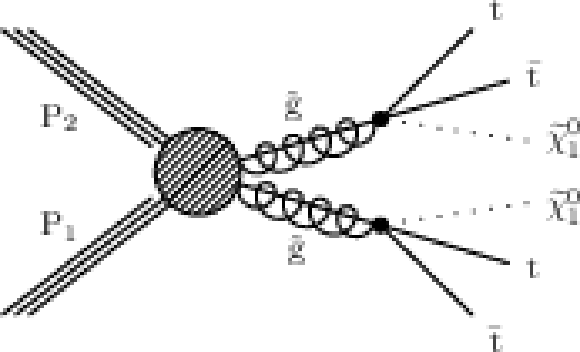
png pdf |
Figure 1-a:
Diagrams for SUSY processes possibly yielding two same-sign leptons in the final state. |

png pdf |
Figure 1-b:
Diagrams for SUSY processes possibly yielding two same-sign leptons in the final state. |

png pdf |
Figure 2-a:
Distributions for the main analysis variables after the baseline selection with ${\mathcal {L}} =$ 12.9 fb$^{-1}$. The shaded area represents the total uncertainty in the background prediction. |

png pdf |
Figure 2-b:
Distributions for the main analysis variables after the baseline selection with ${\mathcal {L}} =$ 12.9 fb$^{-1}$. The shaded area represents the total uncertainty in the background prediction. |
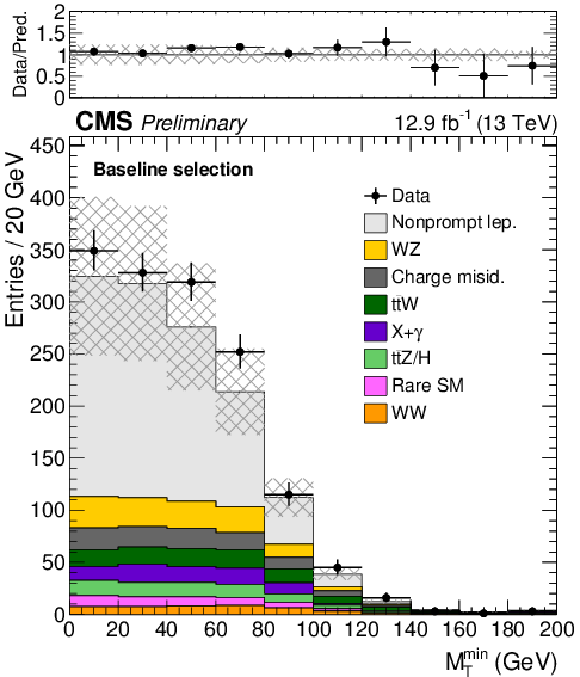
png pdf |
Figure 2-c:
Distributions for the main analysis variables after the baseline selection with ${\mathcal {L}} =$ 12.9 fb$^{-1}$. The shaded area represents the total uncertainty in the background prediction. |
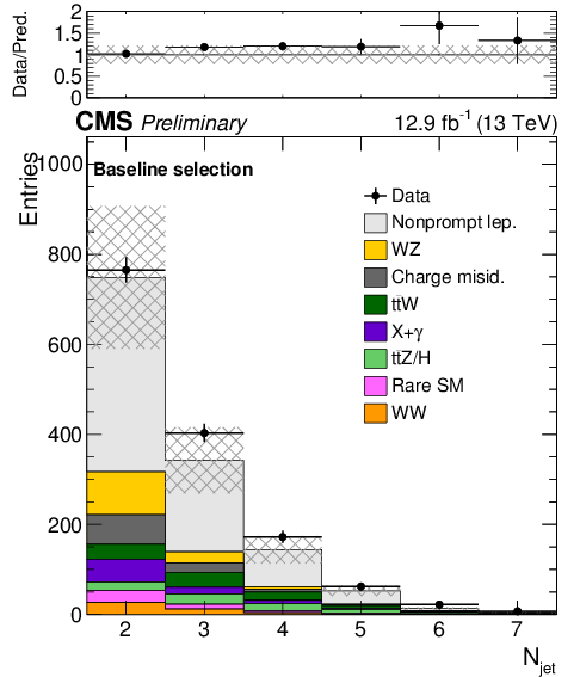
png pdf |
Figure 2-d:
Distributions for the main analysis variables after the baseline selection with ${\mathcal {L}} =$ 12.9 fb$^{-1}$. The shaded area represents the total uncertainty in the background prediction. |
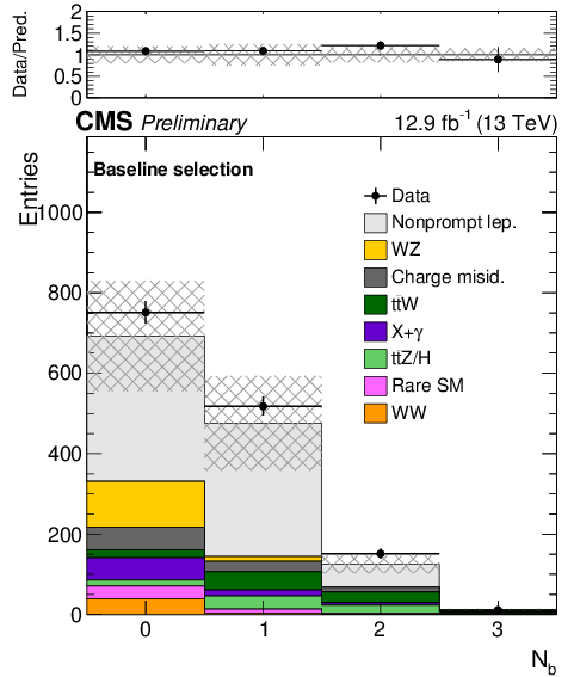
png pdf |
Figure 2-e:
Distributions for the main analysis variables after the baseline selection with ${\mathcal {L}} =$ 12.9 fb$^{-1}$. The shaded area represents the total uncertainty in the background prediction. |

png pdf |
Figure 3-a:
Event yields in HH (a), HL (b), and LL (c) signal regions with ${\mathcal {L}} =$ 12.9 fb$^{-1}$. The shaded area represents the total uncertainty in the background prediction. |

png pdf |
Figure 3-b:
Event yields in HH (a), HL (b), and LL (c) signal regions with ${\mathcal {L}} =$ 12.9 fb$^{-1}$. The shaded area represents the total uncertainty in the background prediction. |
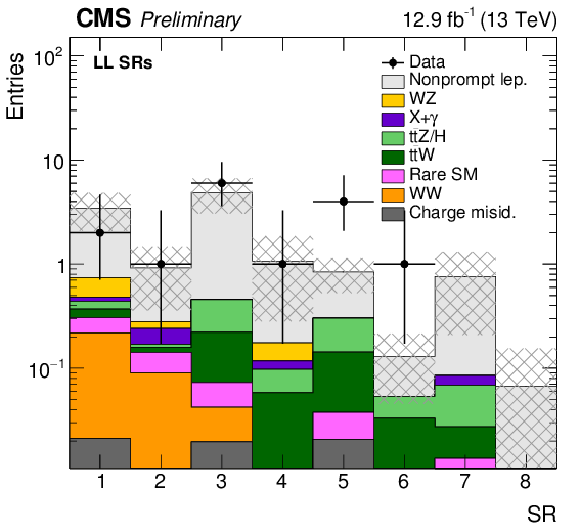
png pdf |
Figure 3-c:
Event yields in HH (a), HL (b), and LL (c) signal regions with ${\mathcal {L}} =$ 12.9 fb$^{-1}$. The shaded area represents the total uncertainty in the background prediction. |
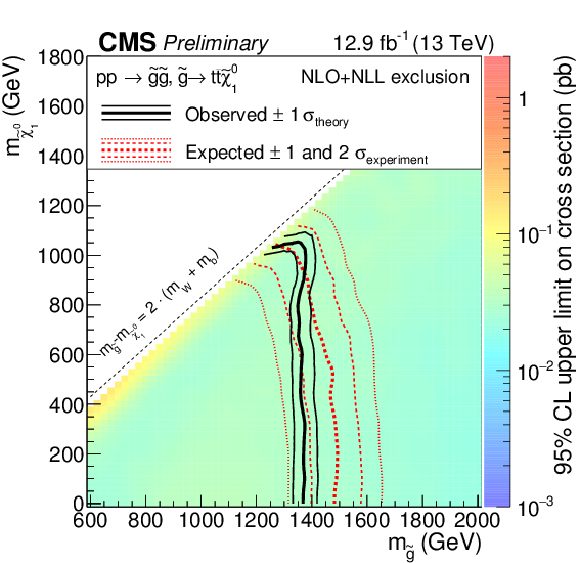
png pdf |
Figure 4:
Exclusion regions at 95% CL in the plane of $m( {\tilde{\chi}^{0}} )$ versus $m( \tilde{\mathrm{g}} )$ for the T1tttt simplified model. The right-hand-side color scale indicates the excluded cross section values for a given point in the SUSY particle mass plane. Observed and expected limit lines indicate the boundaries of excluded regions (to the left and below the curve). |

png pdf |
Figure 5-a:
Exclusion regions at 95% CL in the plane of $m( {\tilde{\chi}^{0}} )$ versus $m( \tilde{\mathrm{g}} )$ for the T5qqqqWW simplified model with $m_{\tilde{\chi}^\pm_1} = 0.5(m_{ \tilde{\mathrm{g}} } + m_{ {\tilde{\chi}^{0}} })$ (a) and $m_{\tilde{\chi}^\pm_1}=m_{ {\tilde{\chi}^{0}} }$ + 20 GeV (b). The right-hand-side color scale indicates the excluded cross section values for a given point in the SUSY particle mass plane. Observed and expected limit lines indicate the boundaries of excluded regions (to the left and below the curve). |

png pdf |
Figure 5-b:
Exclusion regions at 95% CL in the plane of $m( {\tilde{\chi}^{0}} )$ versus $m( \tilde{\mathrm{g}} )$ for the T5qqqqWW simplified model with $m_{\tilde{\chi}^\pm_1} = 0.5(m_{ \tilde{\mathrm{g}} } + m_{ {\tilde{\chi}^{0}} })$ (a) and $m_{\tilde{\chi}^\pm_1}=m_{ {\tilde{\chi}^{0}} }$ + 20 GeV (b). The right-hand-side color scale indicates the excluded cross section values for a given point in the SUSY particle mass plane. Observed and expected limit lines indicate the boundaries of excluded regions (to the left and below the curve). |
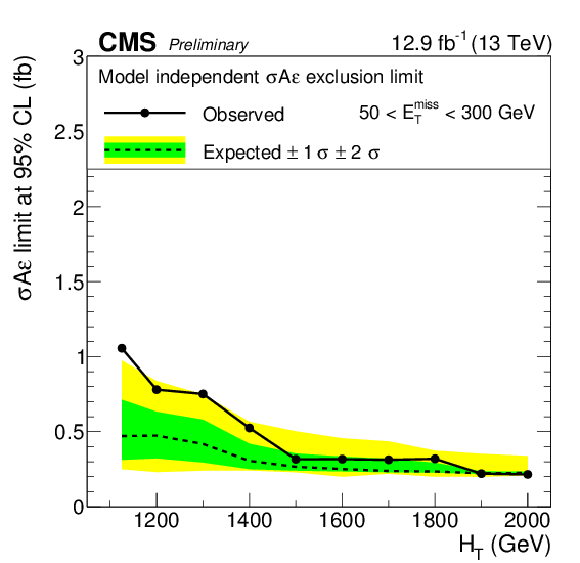
png pdf |
Figure 6-a:
Limits on $\sigma \mathcal {A} \epsilon $ at 95% CL. |

png pdf |
Figure 6-b:
Limits on $\sigma \mathcal {A} \epsilon $ at 95% CL. |
| Tables | |

png pdf |
Table 1:
Multi-isolation working points used in the analysis. |
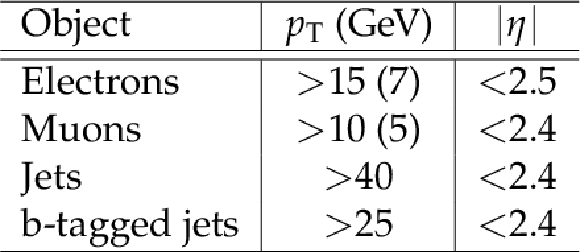
png pdf |
Table 2:
Kinematic and fiducial requirements on tight (loose) leptons and jets that are used in the analysis. |
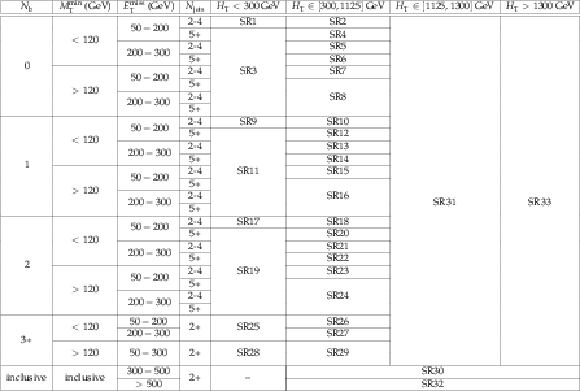
png pdf |
Table 3:
Signal region definitions for the HH lepton selection. |
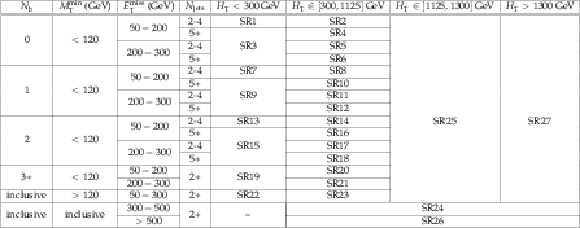
png pdf |
Table 4:
Signal region definitions for the HL lepton selection. |

png pdf |
Table 5:
Signal region definitions for the LL lepton selection. The $ {H_{\mathrm {T}}} >$ 300 GeV requirement is applied in all search regions in this category. |
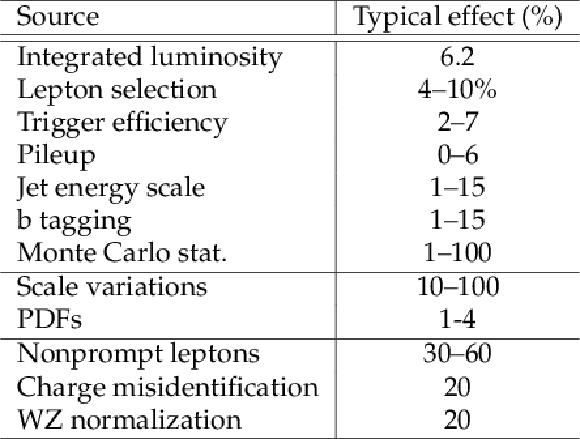
png pdf |
Table 6:
Summary of the sources of uncertainties and their effect on the yield in the signal regions. Reported values are representative for the most relevant signal regions. |
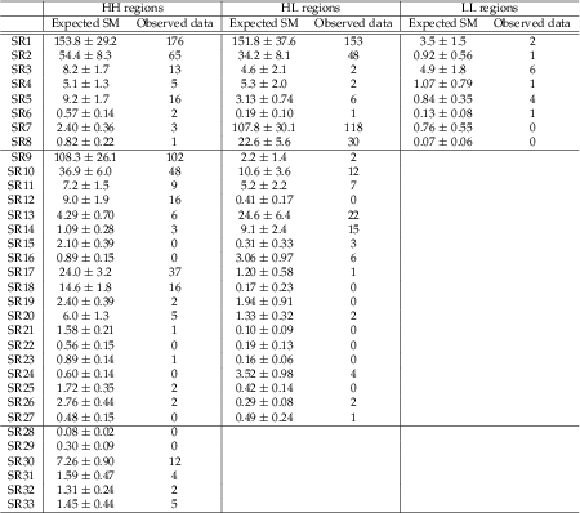
png pdf |
Table 7:
Event yields in the signal regions with ${\mathcal {L}} =$ 12.9 fb$^{-1}$. |
| Summary |
| We have presented the results of a search for new physics in same-sign dilepton events using the CMS detector at the LHC, based on a proton-proton collision data sample at $\sqrt{s} =$ 13 TeV corresponding to an integrated luminosity of 12.9 fb$^{-1}$, collected in the first half of 2016. The data are analyzed in exclusive signal regions defined with different selections on lepton and event kinematic variables, as well as jet and b jet multiplicities. No significant deviations from the standard model expectations are observed. The results are used to set upper limits on the gluino pair production of supersymmetric particles in two simplified models. Gluino masses are probed up to 1350 GeV, extending the sensitivity of previous dilepton searches. In addition, 95% confidence level limits of 1.4 pb and 57 fb are set on the production cross section of two SS top quarks and $\mathrm{ t \bar{t} }\mathrm{ t \bar{t} }$, respectively, and model independent limits and selection efficiencies are provided to allow further interpretations of the results. |
| Additional Figures | |
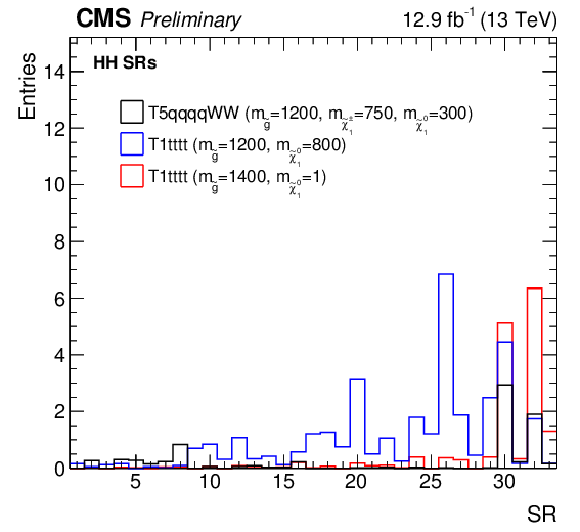
png pdf |
Additional Figure 1:
Event yields in the HH search regions for a few SUSY signal models. |
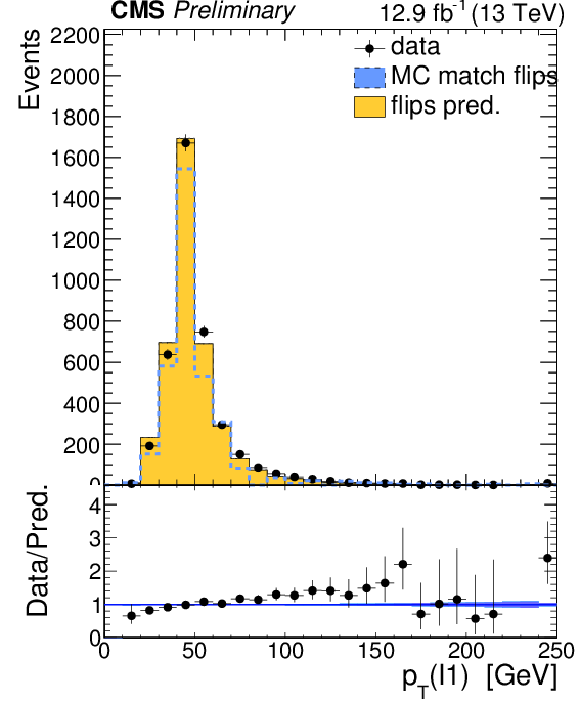
png pdf |
Additional Figure 2:
Comparison of observed and predicted events in the $\mathrm{ Z \rightarrow e^{\pm }e^{\pm } }$ control region as a function of the electron ${p_{\mathrm {T}}} $. The prediction is obtained from $\mathrm{ Z \rightarrow e^{+}e^{-} }$ events reweighted by the charge misidentification probability. |
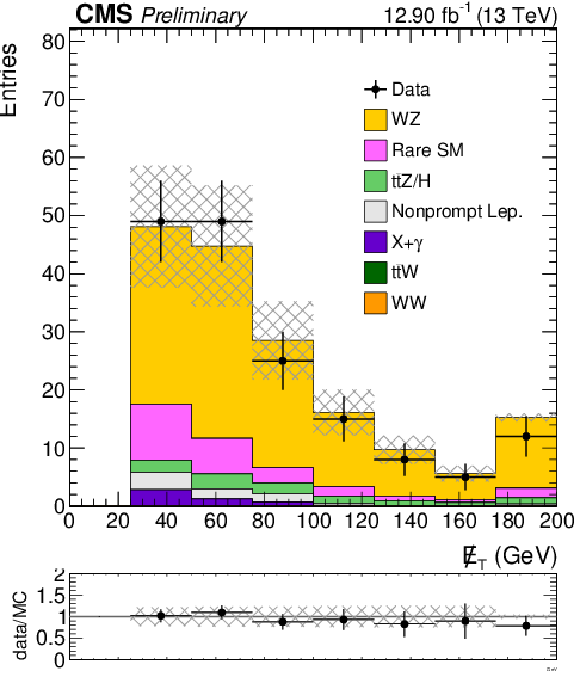
png pdf |
Additional Figure 3:
${E_{\mathrm {T}}^{\text {miss}}}$ distribution in the WZ control region, defined requiring at least two jets, no b jets, ${E_{\mathrm {T}}^{\text {miss}}} > $ 30 GeV, and three leptons, where two of the leptons form a same-flavor, opposite-sign pair with an invariant mass within 15 GeV of the Z boson mass. |
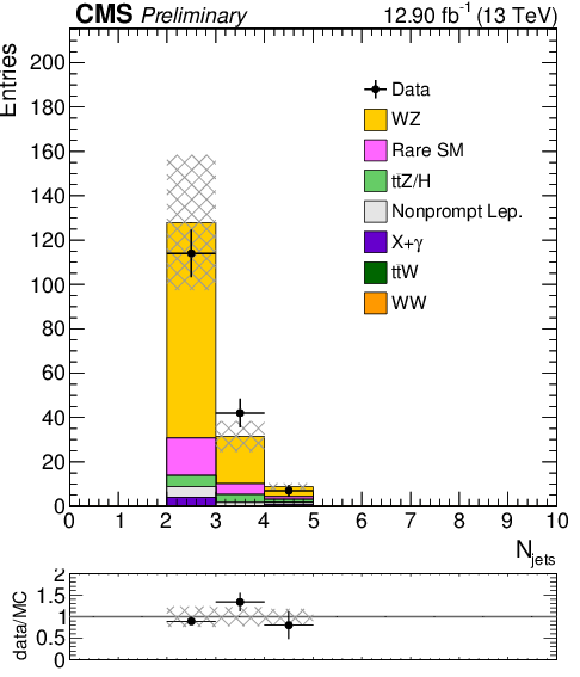
png pdf |
Additional Figure 4:
Number of jets distribution in the WZ control region, defined requiring at least two jets, no b jets, ${E_{\mathrm {T}}^{\text {miss}}} > $ 30 GeV, and three leptons, where two of the leptons form a same-flavor, opposite-sign pair with an invariant mass within 15 GeV of the Z boson mass. |
| Additional Tables | |

png pdf |
Additional Table 1:
Cut flow table for the 'tttt' model assuming gluino and LSP masses equal to 1400 and 1000 GeV, respectively. The last two lines correspond to the most populated search regions. The assumed cross section for this model is 0.0253 pb. |

png pdf |
Additional Table 2:
Cut flow table for the 'tttt' model assuming gluino and LSP masses equal to 1500 and 200 GeV, respectively. The last two lines correspond to the most populated search regions. The assumed cross section for this model is 0.0142 pb. |

png pdf |
Additional Table 3:
Cut flow table for the 'qqqqWW' model with $ m_{ \tilde{\chi }^\pm _1 } = 0.5(m_{ \tilde{g} } + m_{ \tilde{\chi }^0_1} )$ assuming gluino and LSP masses equal to 1000 and 700 GeV, respectively. The last two lines correspond to the most populated search regions. The assumed cross section for this model is 0.3254 pb. |

png pdf |
Additional Table 4:
Cut flow table for the 'qqqqWW' model with $m_{ \tilde{\chi }^\pm _1 } = 0.5(m_{ \tilde{g} } + m_{ \tilde{\chi }^0_1} )$ assuming gluino and LSP masses equal to 1100 and 200 GeV, respectively. The last two lines correspond to the most populated search regions. The assumed cross section for this model is 0.1635 pb. |

png pdf |
Additional Table 5:
Cut flow table for the 'qqqqWW' model with $m_{ \tilde{\chi }^\pm _1 } = 0.5(m_{ \tilde{g} } + m_{ \tilde{\chi }^0_1} )$ assuming gluino and LSP masses equal to 1200 and 400 GeV, respectively. The last two lines correspond to the most populated search regions. The assumed cross section for this model is 0.0856 pb. |

png pdf |
Additional Table 6:
Cut flow table for the 'qqqqWW' model with $m_{ \tilde{\chi }^\pm _1 } = m_{ \tilde{\chi }^0_1} $ + 20 GeV assuming gluino and LSP masses equal to 1400 and 200 GeV, respectively. The last two lines correspond to the most populated search regions. The assumed cross section for this model is 0.0253 pb. |

png pdf |
Additional Table 7:
Cut flow table for the 'qqqqWW' model with $m_{ \tilde{\chi }^\pm _1 } = m_{ \tilde{\chi }^0_1} $ + 20 GeV assuming gluino and LSP masses equal to 1000 and 700 GeV, respectively. The last two lines correspond to the most populated search regions. The assumed cross section for this model is 0.3254 pb. |
| References | ||||
| 1 | CMS Collaboration | The CMS experiment at the CERN LHC | JINST 3 (2008) S08004 | CMS-00-001 |
| 2 | CMS Collaboration | Search for new physics in events with same-sign dileptons and b jets in pp collisions at $ \sqrt{s}=8 $ TeV | JHEP 03 (2013) 037 | CMS-SUS-12-017 1212.6194 |
| 3 | CMS Collaboration | Search for new physics in events with same-sign dileptons and jets in pp collisions at 8 TeV | JHEP 01 (2014) 163 | CMS-SUS-13-013 1311.6736 |
| 4 | CMS Collaboration | Search for SUSY in same-sign dilepton events at 13 TeV | \it Accepted by EPJC | CMS-SUS-15-008 1605.03171 |
| 5 | ATLAS Collaboration | Search for supersymmetry at $ \sqrt{s}=13 $ TeV in final states with jets and two same-sign leptons or three leptons with the ATLAS detector | The European Physical Journal C 76 (2016), no. 5, 1--26 | |
| 6 | CMS Collaboration | Performance of Electron Reconstruction and Selection with the CMS Detector in Proton-Proton Collisions at vs = 8 TeV | JINST 10 (2015) P06005 | CMS-EGM-13-001 1502.02701 |
| 7 | CMS Collaboration | Performance of CMS muon reconstruction in pp collision events at sqrt(s) = 7 TeV | JINST 7 (2012) P10002 | CMS-MUO-10-004 1206.4071 |
| 8 | K. Rehermann and B. Tweedie | Efficient Identification of Boosted Semileptonic Top Quarks at the LHC | JHEP 03 (2011) 059 | 1007.2221 |
| 9 | CMS Collaboration | Particle-flow event reconstruction in CMS and performance for jets, taus, and $ E_{\mathrm{T}}^{\text{miss}} $ | CDS | |
| 10 | CMS Collaboration | Commissioning of the particle-flow event reconstruction with the first LHC collisions recorded in the CMS detector | CDS | |
| 11 | M. Cacciari, G. P. Salam, and G. Soyez | The anti-$ k_\text{T} $ jet clustering algorithm | JHEP 04 (2008) 063 | 0802.1189 |
| 12 | CMS Collaboration | Jet Energy Calibration in the 8 TeV pp data | ||
| 13 | CMS Collaboration | Identification of b-quark jets with the CMS experiment | JINST 8 (2013) P04013 | CMS-BTV-12-001 1211.4462 |
| 14 | CMS Collaboration | Performance of b tagging at $ \sqrt{s}=8 $ TeV in multijet, $ \mathrm{ t \bar{t} } $ and boosted topology events | CDS | |
| 15 | CMS Collaboration | Identification of double-b quark jets in boosted event topologies | CDS | |
| 16 | J. Alwall et al. | The automated computation of tree-level and next-to-leading order differential cross sections, and their matching to parton shower simulations | JHEP 07 (2014) 079 | 1405.0301 |
| 17 | T. Melia, P. Nason, R. Rontsch, and G. Zanderighi | $ \mathrm{ W }^{+}\mathrm{ W }{-} $, WZ and ZZ production in the POWHEG BOX | JHEP 11 (2011) 078 | 1107.5051 |
| 18 | T. Sjostrand, S. Mrenna, and P. Z. Skands | A Brief Introduction to PYTHIA 8.1 | CPC 178 (2008) 852 | 0710.3820 |
| 19 | CMS Collaboration | Event generator tunes obtained from underlying event and multiparton scattering measurements | EPJC 76 (2016) 155 | CMS-GEN-14-001 1512.00815 |
| 20 | GEANT4 Collaboration | $ Geant 4--a $ simulation toolkit | NIMA 506 (2003) 250 | |
| 21 | S. Abdullin et al. | The fast simulation of the CMS detector at LHC | J. Phys. Conf. Ser. 331 (2011) 032049 | |
| 22 | N. Collaboration | Parton distributions for the LHC Run II | JHEP 04 (2015) 040 | 1410.8849 |
| 23 | M. V. Garzelli, A. Kardos, C. G. Papadopoulos, and Z. Trocsanyi | $ \mathrm{ t \bar{t} } $W$ ^{\pm} $ and $ \mathrm{ t \bar{t} } $Z Hadroproduction at NLO accuracy in QCD with Parton Shower and Hadronization effects | JHEP 11 (2012) 056 | 1208.2665 |
| 24 | G. Cowan, K. Cranmer, E. Gross, and O. Vitells | Asymptotic formulae for likelihood-based tests of new physics | EPJC 71 (2011) 1554, , [Erratum: \DOI10.1140/epjc/s10052-013-2501-z] | 1007.1727 |
| 25 | A. L. Read | Presentation of search results: The CL$ _S $ technique | JPG 28 (2002) 2693 | |
| 26 | T. Junk | Confidence level computation for combining searches with small statistics | NIMA 434 (1999) 435 | hep-ex/9902006 |
| 27 | ATLAS and CMS Collaborations | Procedure for the LHC Higgs boson search combination in summer 2011 | ATL-PHYS-PUB-2011-011, CMS NOTE-2011/005 | |
| 28 | W. Beenakker, R. H\"opker, M. Spira, and P. M. Zerwas | Squark and gluino production at hadron colliders | Nucl. Phys. B 492 (1997) 51 | hep-ph/9610490 |
| 29 | A. Kulesza and L. Motyka | Threshold resummation for squark-antisquark and gluino-pair production at the LHC | PRL 102 (2009) 111802 | 0807.2405 |
| 30 | A. Kulesza and L. Motyka | Soft gluon resummation for the production of gluino-gluino and squark-antisquark pairs at the LHC | PRD 80 (2009) 095004 | 0905.4749 |
| 31 | W. Beenakker et al. | Soft-gluon resummation for squark and gluino hadroproduction | JHEP 12 (2009) 041 | 0909.4418 |
| 32 | W. Beenakker et al. | Squark and gluino hadroproduction | Int. J. Mod. Phys. A 26 (2011) 2637 | 1105.1110 |
| 33 | M. Kr\"amer et al. | Supersymmetry production cross sections in pp collisions at $ \sqrt{s}=7 $ TeV | 1206.2892 | |
| 34 | C. Borschensky et al. | Squark and gluino production cross sections in pp collisions at $ \sqrt{s} $ = 13, 14, 33 and 100 TeV | EPJC 74 (2014) 3174 | 1407.5066 |

|
Compact Muon Solenoid LHC, CERN |

|

|

|

|

|

|